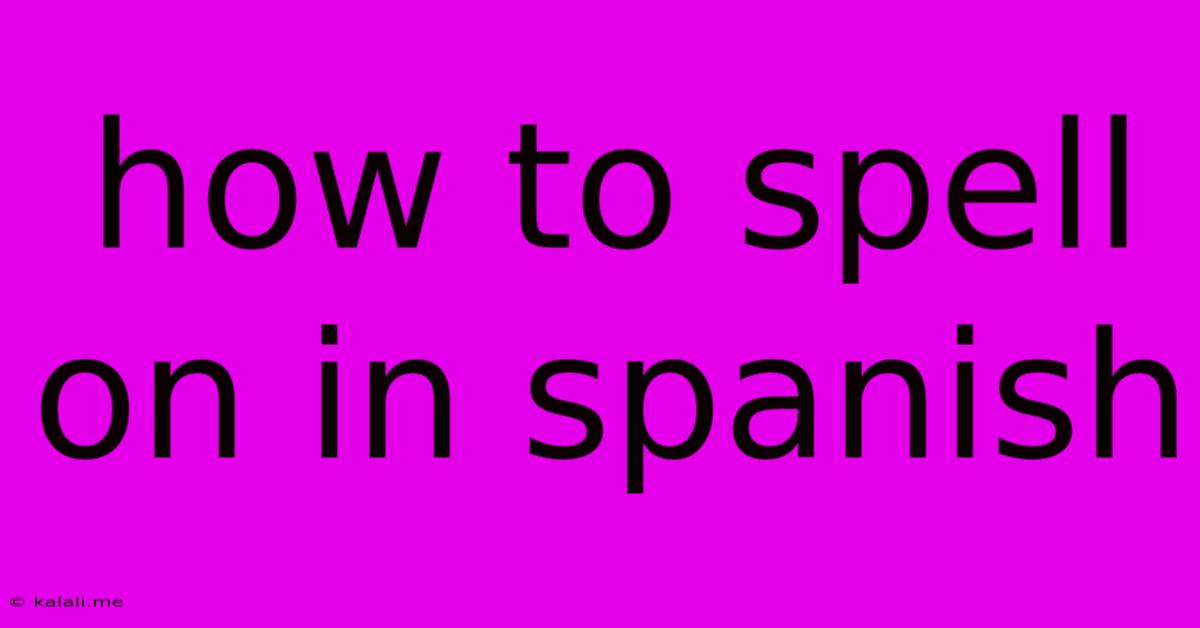How To Spell On In Spanish
Kalali
May 25, 2025 · 2 min read

Table of Contents
How to Spell "On" in Spanish: A Comprehensive Guide
Meta Description: Learn the various ways to say "on" in Spanish, depending on the context. This guide covers different prepositions and their uses, ensuring you choose the right word every time. Mastering Spanish prepositions is key to fluent communication!
Saying "on" in Spanish isn't as straightforward as it is in English. The best translation depends heavily on the context. This guide will break down the most common ways to express the concept of "on" in Spanish, helping you choose the right word for every situation. We'll cover the key prepositions and provide examples to solidify your understanding.
Understanding the Nuances of "On"
The English word "on" can represent several different relationships, including:
- Location: Something is situated on a surface.
- Time: Something happens on a specific day or time.
- Means of transportation: Traveling on a vehicle.
- State or condition: Being on a diet, on fire, etc.
Therefore, there isn't one single Spanish equivalent. Let's explore the most common options:
1. En (In/On) – The Most Versatile Option
En is the most frequently used preposition for "on" in Spanish. It generally indicates location and can be used for both enclosed spaces ("in") and surfaces ("on").
- Location on a surface: "The book is on the table." - El libro está en la mesa.
- Location within a larger area: "The meeting is on Monday." - La reunión es en lunes. (Note: Days of the week typically use 'en')
- Means of transportation: "I'm on the bus." - Estoy en el autobús.
Note: While en often translates to "in," its usage with surfaces makes it the closest equivalent for many "on" situations.
2. Sobre (On Top Of/Above) – Emphasizing Position
Sobre emphasizes that something is positioned directly on top of something else. It's more precise than en when the vertical position is important.
- "The cat is on the roof." - El gato está sobre el techo. (Clearly on top)
- "The picture is on the wall." - El cuadro está sobre la pared. (Hung on the wall)
3. A bordo de (On Board) – For Transportation
For situations involving transportation, a bordo de is a more formal and specific way to express "on."
- "He's on the plane." - Él está a bordo del avión.
4. Contextual Variations – Other Possibilities
The best way to express "on" sometimes depends entirely on the context. Consider these examples:
- "On television": En la televisión
- "On the radio": En la radio
- "On sale": En oferta
- "On fire": En llamas
Mastering "On" in Spanish: Practice Makes Perfect
The key to mastering the use of "on" in Spanish is practice and exposure to the language. Pay close attention to how native speakers use these prepositions in various contexts. Reading Spanish texts, listening to Spanish conversations, and actively using the language yourself will help you develop an intuitive sense of when to use en, sobre, and other options. Don't be afraid to make mistakes—it's part of the learning process!
Latest Posts
Latest Posts
-
How To Remove A Three Way Switch
May 25, 2025
-
Pilot Light On Magic Chef Oven
May 25, 2025
-
Is Tomato Puree The Same As Tomato Sauce
May 25, 2025
-
Ceiling Fan Wiring Diagram 3 Speed
May 25, 2025
-
Whats The Difference Between Dumb And Stupid
May 25, 2025
Related Post
Thank you for visiting our website which covers about How To Spell On In Spanish . We hope the information provided has been useful to you. Feel free to contact us if you have any questions or need further assistance. See you next time and don't miss to bookmark.